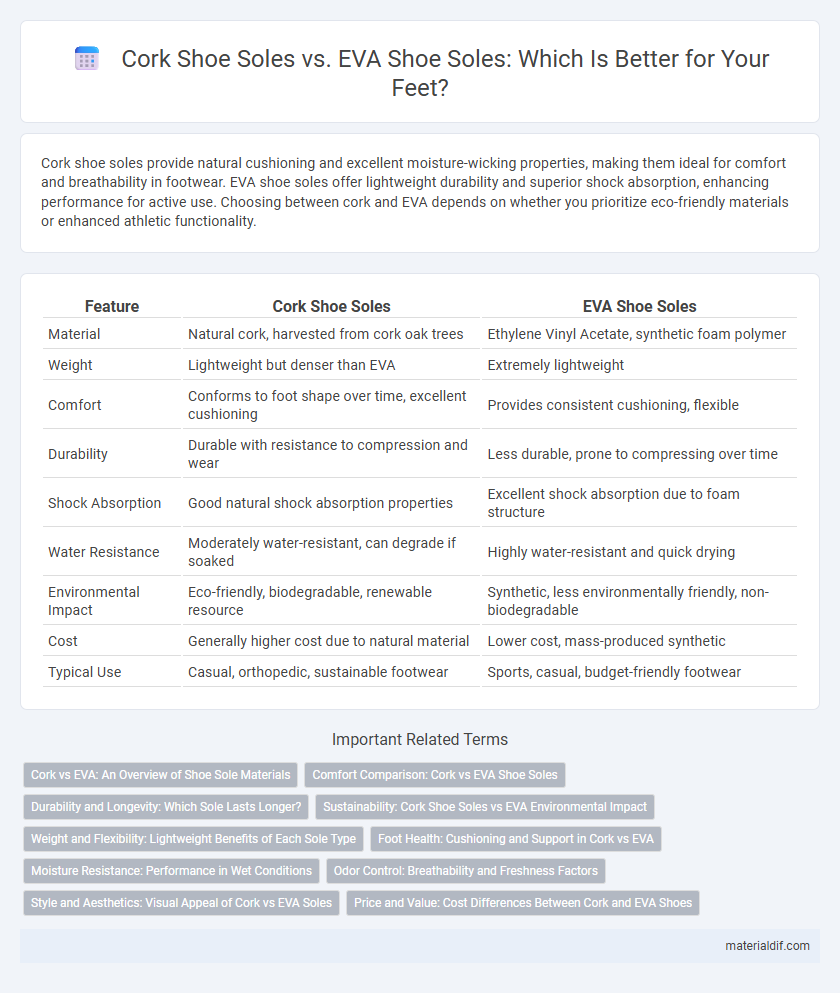Cork shoe soles provide natural cushioning and excellent moisture-wicking properties, making them ideal for comfort and breathability in footwear. EVA shoe soles offer lightweight durability and superior shock absorption, enhancing performance for active use. Choosing between cork and EVA depends on whether you prioritize eco-friendly materials or enhanced athletic functionality.
Table of Comparison
| Feature | Cork Shoe Soles | EVA Shoe Soles |
|---|---|---|
| Material | Natural cork, harvested from cork oak trees | Ethylene Vinyl Acetate, synthetic foam polymer |
| Weight | Lightweight but denser than EVA | Extremely lightweight |
| Comfort | Conforms to foot shape over time, excellent cushioning | Provides consistent cushioning, flexible |
| Durability | Durable with resistance to compression and wear | Less durable, prone to compressing over time |
| Shock Absorption | Good natural shock absorption properties | Excellent shock absorption due to foam structure |
| Water Resistance | Moderately water-resistant, can degrade if soaked | Highly water-resistant and quick drying |
| Environmental Impact | Eco-friendly, biodegradable, renewable resource | Synthetic, less environmentally friendly, non-biodegradable |
| Cost | Generally higher cost due to natural material | Lower cost, mass-produced synthetic |
| Typical Use | Casual, orthopedic, sustainable footwear | Sports, casual, budget-friendly footwear |
Cork vs EVA: An Overview of Shoe Sole Materials
Cork shoe soles offer natural shock absorption, excellent breathability, and eco-friendly sustainability due to their renewable cork oak material. EVA shoe soles, made from ethylene-vinyl acetate foam, provide superior lightweight cushioning, flexibility, and durability, making them popular for athletic and casual footwear. Cork excels in moisture-wicking and temperature regulation, while EVA is favored for its impact resistance and ease of molding in various sole designs.
Comfort Comparison: Cork vs EVA Shoe Soles
Cork shoe soles offer superior cushioning and natural shock absorption due to their ability to mold to the foot's shape over time, providing personalized comfort and breathability. EVA shoe soles provide lightweight flexibility and excellent impact resistance, making them ideal for high-intensity activities requiring quick response and support. Cork excels in long-lasting comfort and moisture management, while EVA prioritizes durability and lightweight performance.
Durability and Longevity: Which Sole Lasts Longer?
Cork shoe soles offer excellent durability due to their natural resilience and ability to mold to the foot over time while maintaining structural integrity. EVA (Ethylene Vinyl Acetate) soles provide lightweight cushioning but tend to compress and wear down faster under frequent use. For longevity, cork soles generally last longer, making them ideal for shoes designed for extended wear and enhanced comfort.
Sustainability: Cork Shoe Soles vs EVA Environmental Impact
Cork shoe soles offer superior sustainability due to cork's renewable harvesting process, where bark is stripped without damaging the tree, allowing continuous growth and carbon sequestration. EVA shoe soles, though lightweight and flexible, are derived from non-biodegradable petrochemicals, contributing to plastic pollution and resource depletion. Cork's biodegradability and lower carbon footprint make it an environmentally preferable choice compared to EVA in sustainable footwear production.
Weight and Flexibility: Lightweight Benefits of Each Sole Type
Cork shoe soles offer exceptional lightweight properties due to their natural cellular structure, making them ideal for reducing overall shoe weight and enhancing comfort during extended wear. EVA shoe soles provide superior flexibility and cushioning, which contributes to a lightweight feel while allowing for dynamic movement and shock absorption. Both materials prioritize weight reduction, with cork excelling in breathable, eco-friendly durability and EVA delivering responsive flexibility for active lifestyles.
Foot Health: Cushioning and Support in Cork vs EVA
Cork shoe soles provide superior natural cushioning by conforming to the foot's shape, promoting better arch support and reducing foot fatigue. EVA (Ethylene Vinyl Acetate) soles offer lightweight shock absorption but may lack the adaptive support that cork naturally provides. The breathable and antimicrobial properties of cork enhance foot health by preventing moisture buildup and odor, advantages less pronounced in EVA soles.
Moisture Resistance: Performance in Wet Conditions
Cork shoe soles naturally resist moisture due to their cellular structure, offering superior breathability and comfort in wet conditions compared to EVA shoe soles. EVA soles, while lightweight and flexible, can absorb water over time, which may reduce their performance and durability in consistently damp environments. Choosing cork soles enhances moisture management and provides better long-term resistance against water exposure in footwear designed for wet climates.
Odor Control: Breathability and Freshness Factors
Cork shoe soles naturally excel in odor control due to their superior breathability and moisture-wicking properties, which help maintain foot freshness by allowing air circulation and preventing sweat buildup. EVA shoe soles, while lightweight and shock-absorbent, often lack the porous structure necessary for optimal ventilation, leading to less effective odor management. The antimicrobial qualities of cork also contribute significantly to reducing bacterial growth, making cork soles a preferred choice for long-lasting freshness in footwear.
Style and Aesthetics: Visual Appeal of Cork vs EVA Soles
Cork shoe soles offer a natural, textured appearance that complements eco-friendly and artisanal footwear styles, providing a warm, earthy aesthetic. EVA shoe soles present a sleek, smooth finish available in various colors, enhancing modern and sporty shoe designs with a clean and lightweight look. The choice between cork and EVA soles significantly impacts the overall style, with cork emphasizing organic charm and EVA focusing on contemporary versatility.
Price and Value: Cost Differences Between Cork and EVA Shoes
Cork shoe soles typically cost more than EVA soles due to natural material sourcing and sustainable production processes, reflecting higher durability and eco-friendliness value. EVA soles are generally less expensive, making them a budget-friendly option with lightweight cushioning but may wear out faster than cork. Consumers seeking long-term comfort and environmental benefits often consider the initial higher price of cork soles justified by their longevity and natural shock absorption.
Cork Shoe Soles vs EVA Shoe Soles Infographic

 materialdif.com
materialdif.com